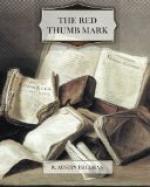“But surely the process you have described is a very difficult and intricate one?”
“Not at all; it is very little more difficult than ordinary carbon printing, which is practised successfully by numbers of amateurs. Moreover, such a relief as I have described—which is practically nothing more than an ordinary process block—could be produced by any photo-engraver. The process that I have described is, in all essentials, that which is used in the reproduction of pen-and-ink drawings, and any of the hundreds of workmen who are employed in that industry could make a relief-block of a finger-print, with which an undetectable forgery could be executed.”
“You have asserted that the counterfeit finger-print could not be distinguished from the original. Are you prepared to furnish proof that this is the case?”
“Yes. I am prepared to execute a counterfeit of the prisoner’s thumb-print in the presence of the Court.”
“And do you say that such a counterfeit would be indistinguishable from the original, even by the experts?”
“I do.”
Anstey turned towards the judge. “Would your lordship give your permission for a demonstration such as the witness proposes?”
“Certainly,” replied the judge. “The evidence is highly material. How do you propose that the comparison should be made?” he added, addressing Thorndyke.
“I have brought, for the purpose, my lord,” answered Thorndyke, “some sheets of paper, each of which is ruled into twenty numbered squares. I propose to make on ten of the squares counterfeits of the prisoner’s thumb-mark, and to fill the remaining ten with real thumb-marks. I propose that the experts should then examine the paper and tell the Court which are the real thumb-prints and which are the false.”




